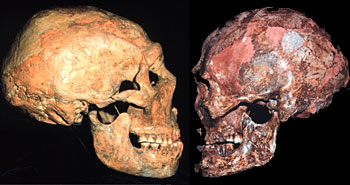Could it be that in the great evolutionary “family tree,” it is we Modern Humans, not the brow-ridged, large-nosed Neandertals, who are the odd uncle out?
New research published in the August, 2006 journal Current Anthropology by Neandertal and early modern human expert, Erik Trinkaus, Ph.D., professor of anthropology at Washington University in St. Louis, suggests that rather than the standard straight line from chimps to early humans to us with Neandertals off on a side graph, it’s equally valid, perhaps more valid based on the fossil record, that the line should extend from the common ancestor to the Neandertals, and Modern Humans should be the branch off that.

Trinkaus has spent years examining the fossil record and began to realize that maybe researchers have been looking at our ancient ancestors the wrong way.
Trinkaus identified fossil traits which seemed to be genetic markers – those not greatly influenced by environment, life ways and wear and tear. He was careful to examine traits that appear to be largely independent of each other to avoid redundancy.
“I wanted to see to what extent Neandertals are derived, that is distinct, from the ancestral form. I also wanted to see the extent to which modern humans are derived relative to the ancestral form,” Trinkaus says. “What I came up with is that modern humans have about twice as many uniquely derived traits than do the Neandertals.
“In the broader sweep of human evolution,” says Trinkaus, “the more unusual group is not Neandertals, whom we tend to look at as strange, weird and unusual, but it’s us – Modern Humans.”
The most unusual characteristics throughout human anatomy occur in Modern Humans, argues Trinkaus. “If we want to better understand human evolution, we should be asking why Modern Humans are so unusual, not why the Neandertals are divergent. Modern Humans, for example, are the only people who lack brow ridges. We are the only ones who have seriously shortened faces. We are the only ones with very reduced internal nasal cavities. We also have a number of detailed features of the limb skeleton that are unique.”
Trinkaus admits that every paleontologist will define the traits a little differently. “If you really wanted to, you could make the case that Neandertals look stranger than we do. But if you are reasonably honest about it, I think it would be extraordinarily difficult to make Neandertals more derived than Modern Humans.”